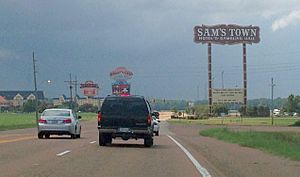Commerce, Mississippi facts for kids
Quick facts for kids
Commerce, Mississippi
|
|
|---|---|

Looking west from Commerce
|
|
| Country | United States |
| State | Mississippi |
| County | Tunica |
| Elevation | 200 ft (61 m) |
| Time zone | UTC-6 (Central (CST)) |
| • Summer (DST) | UTC-5 (CDT) |
| GNIS feature ID | 668724 |
Commerce is a ghost town in Tunica County, Mississippi, in the United States. A ghost town is a place where most people have left, and little is left of the original buildings. The town's port was called Commerce Landing.
Commerce is located right on the Mississippi River. It is about 4 mi (6.4 km) west of Tunica Resorts.
Long ago, Commerce was a busy river port. Today, it is mostly farmland. You can also find large casinos nearby. Not much is left of the old town.
Contents
History of Commerce
Commerce has a long and interesting history. It was once a very important place.
Early Days and Explorers
Some historians believe that the Spanish explorer Hernando de Soto may have crossed the Mississippi River near Commerce. This happened around the year 1541.
Archaeologists have found old sites in Commerce from that time. They found pottery from the Late Mississippian period. This matches what the Spanish wrote about meeting three Quizquiz Indian villages near the river.
A Growing Town
In the 1820s, Commerce was a rival to Memphis, Tennessee. Both towns were important for trade. By 1839, Commerce actually had more people living there than Memphis. Memphis is about 40 mi (64 km) north on the Mississippi River.
Commerce was founded in 1834. An early settler named Thomas Fletcher, along with a Choctaw Indian, gave the town its name. They hoped it would become a very important city for trade. In 1836, Commerce became the main town for Tunica County. It officially became a town in 1839. It was the first town in Tunica County.
River Life and Challenges
During the 1840s, an artist named John Banvard visited Commerce. He traveled the Mississippi River with a floating art show. There's a story that a local official tried to make him pay a special fee. Banvard's crew then floated away with the official still on board! They left him on the other side of the river.
A railroad was almost finished in Commerce in 1840. But the government took away the railroad's charter. This caused the bank and the railroad to go bankrupt.
In 1843, the Mississippi River changed its path. Part of Commerce Landing went underwater. To protect their homes, the people built the first levees in this part of the Delta. Levees are like walls that hold back river water. The county seat had to move for a short time. But it moved back to Commerce six months later. Then it moved again to Austin.
In 1849, an explorer named Samuel Washington Woodhouse stopped near Commerce. He wrote about stopping to get wood for his boat.
Later Years and Notable Events
Much of the land in Commerce was sold to Ransom H. Byrn. He grew cotton there. By 1860, he was a very large cotton farmer in Tunica County.
In 1888, a fast steamboat called the Kate Adams caught fire near Commerce. Twenty-three people died. The people of Commerce helped the survivors. They gave them food, clothes, and rides.
The famous blues musician Robert Johnson lived in Commerce as a child in the 1920s. He lived on the Abbay & Leatherman plantation. He went to Indian Creek School nearby. Today, there is a Mississippi Blues Trail marker in Commerce. This marker tells about the area's connection to blues music.
In 1955, a strong tornado hit the Abbay & Leatherman plantation. It killed 28 people. The tornado was 200 ft (61 m) wide. It destroyed houses, a school, a church, and a cotton gin. Most of the people who died were children and their teacher because the school was in session.


